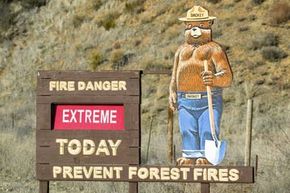A Campaign for and Against Forest Fires
The campaign against forest fires has a lengthy history in the U.S., one that gained an emotional foothold in 1944 when the U.S. Forest Service introduced a fire-injured bear named Smokey. His message, "Only you can prevent forest fires," is important, considering that four out of five wildfires are started through the carelessness of campers or passersby [source: National Geographic].
By 2001, however, another strategy began to accompany this message of prevention. The Forest Service created a National Fire Plan to address the tinderbox conditions caused by decades of fire suppression, drought and scores of residential developments neighboring forests [source: U.S. Forest Service]. It is a multipronged approach that includes fighting fires by land and air, as well as controlled burns. These deliberately set and controlled fires are designed to take place under specific conditions and confine the flames to a predetermined area.
Advertisement
In general, the boundaries of a controlled burn include natural fireguards, such as streams, or man-made fireguards, such as tilled soil or gravel roadways. Before a burn takes place, weather must be taken into account. Too windy, and sparks will spread to unintended areas; too wet, and fuel will not burn. Most controlled burns take place when the wind is 5 miles to 15 miles per hour (8 to 24 kilometers per hour) and coming from a consistent direction. In addition to notifying neighbors and local enforcement agencies of the burn (in many cases, a permit is required), a local fire department should be on the scene in case the fire burns out of control.
Controlled burns begin by lighting a backfire using a flammable liquid, such as gasoline, along the downwind perimeter of the prescribed area. The fire will then burn slowly, usually with low flames, because it is moving against the wind. Additional flank fires may be lit along boundaries parallel to the wind. Finally, a fire is set along the boundary opposite the downwind perimeter. The fires burn toward each other, consuming all the fuel in their path and dying out upon meeting [source: Porter].
The idea behind controlled burns is to reduce the fuel that could feed a forest fire, should one start under uncontrolled circumstances. This dangerous scenario has become all too common in the American West, where heat and drought have turned entire sections of forest into kindling, ready to be sparked by lightning or lit cigarettes, and fanned by strong winds [source: Krock].
Yet, even these catastrophic events benefit living things, too.
